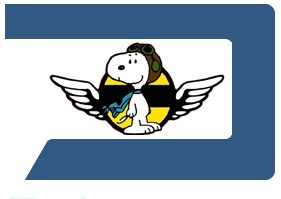

Building the MachNone
A Sky Pup Construction Project
Sky Pup
Over the last few years, I have received a number of reports of difficulty with the first flight resulting in minor damage (usually the landing gear). In almost every case, the cause has been failure to follow the instructions from Sport Flight, or failure to follow common ultralight flying principles, or failure to follow procedures common to all aircraft.
Never conduct fast taxi tests with and aircraft that is not totally ready to fly. That means the seat belt must be installed, there must be enough fuel onboard for at least 30 minutes, and the pilot should have a helmet. A number of builders have found themselves in the air before they were ready. You should have at least a 1000 ft runway with no obstacles. Grass is much better than pavement.
Test flights should be conducted only in the calmest conditions. (A direct quote from the Sky Pup manual.) Regardless of your experience in other aircraft, there should be no wind. In calm conditions you can fast taxi both directions and land either direction if needed. Also if an off-field landing becomes necessary, you are not limited by the wind direction. Why take chances? The best times are early in the morning and late in he evening. In the morning, conditions will gradually worsen as the wind and turbulence picks up due to heating from the son. Early evening is best as the conditions will usually improve toward sunset. If you are worried about landing in the dark, then takeoff so you will run out of fuel before darkness begins. At least you will have light for your forced landing.
Avoid flying close to the ground at low airspeed. Many experts suggest you make low hops before climbing to altitude. Others disagree. The idea is to find out if the plane is in reasonable trim and will maintain level flight without excess control deflection. Only a few feet of altitude is needed for this test. As long as the controls are somewhere near the middle of their range, you are OK. The most common cause of landing gear damage on the first flight seems to be low airspeed on initial hops. If you are 10 to 15 up at minimum airspeed, and you drift off the runway, the controls may not respond quickly enough to straighten it out. Keep those initial hops low and only in calm conditions!
For the initial takeoff. The best technique is to keep the tail about halfway between level attitude and tail on the ground and wait for it to lift off by itself. If it doesn’t, then add more back stick. Once you break ground, let the sick come forward to build up more speed. You will feel the controls become more responsive. If the stick is well back or far forward in level flight, your CG or trim may be off. Do not climb steeply on the first flight. It’s possible to have the nose so high it will only mush along at low airspeed and not gain altitude.
Climb straight out to several hundred feed before making any turns. The rudder control is very effective and you should have no problems getting the feel of it. Notice if the rudder controls are near the middle when in level flight. A strong turning tendency indicates wing or vertical tail misalignment. If you are holding too much back pressure or forward pressure on the stick, you may have to adjust the CG or the tail incidence. Before your first landing, climb to 500 to 1000 feet and explore the slow flight characteristics of your Pup. Reduce power and let the nose come down for a normal glide. Take note of the stick pressure and position and aircraft attitude you will be using in a landing approach. Next, ease the stick back farther until you begin to feel an increased sink rate (and probably more stick pressure). Avoid this condition when near the ground.
Landing is the easiest part. Make a long straight approach with partial power and normal glide speed. Adjust the throttle so you will make the runway. You only have to fly level close to the ground and reduce power when the wheels touch. Your first landing may be fast so be careful of lowering the tail too soon or it will takeoff again……the next step is to enter your first flight in a log book!
Some Tips For Your First Flight
(from Sky Pup News #25 June 1990)